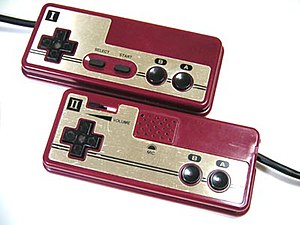D-pad: Difference between revisions
Added some internal links and minor typographical corrections |
pl:D-pad |
||
| Line 46: | Line 46: | ||
[[Category:Game controllers]] |
[[Category:Game controllers]] |
||
[[ja:十字キー]] |
[[ja:十字キー]] |
||
[[pl:D-pad]] |
|||
Revision as of 18:47, 21 May 2006

A D-pad (short for directional pad) is a plus sign–shaped control found on nearly all modern video game console gamepads and game controllers, with one button on each point. Like early video game joysticks, the vast majority of D-pads are digital; in other words, only the directions provided on the D-pad buttons can be used, with no intermediate values. However, combinations of two directions (up and left, for example) do provide diagonals.
Although digital D-pads offer less nuance and flexibility than analog sticks, they can easily be manipulated (requiring little movement of the thumb) with very high accuracy. In recent years, D-pads have been developed which can measure different levels of pressure, giving a degree of analog control.
History
A precursor to the standard D-pad was used by the Intellivision console, which was released by Mattel Electronics in 1980. The Intellivision's unique controller featured the first alternative to a joystick on a home console, a circular pad that allowed for 16 directions of movement by pressing it with the thumb. A precursor to the D-pad also appeared on Entex's short lived "Select A Game" cartridge based handheld system; it featured non-connected raised left, right, up and down buttons aligned to the left of a row of action buttons.
The first "connected" (pad) style D-pad appeared appropriately enough in 1981 on a handheld game system- "Cosmic Hunter" on Milton Bradley's Microvision. The pad was operated the same way today's dpads do, using the thumb to manipulate the onscreen "hero" character in any of four directions.
In 1982, Nintendo's Gunpei Yokoi updated this idea, shrinking it and altering the points into the familiar modern "cross" design for their Donkey Kong handheld game. The design proved to be popular for subsequent Game & Watch titles, although the previously introduced non-connected D-pad style was still utilized on various later Game & Watch titles, including the Super Mario Brothers handheld game. This particular design was patented.
Initially intended to be a compact controller for the Game & Watch handheld games alongside the prior nonconnected style pad, Nintendo realized that Gunpei's updated design would also be appropriate for regular consoles, and Nintendo made the D-pad the standard directional control for the hugely successful Famicom/Nintendo Entertainment System. All major video game consoles since have had a D-pad on their controllers. Arcade games, however, have largely continued using joysticks.
A recent trend in modern consoles, beginning with the Nintendo 64, has been to provide both a D-pad and a compact thumb-operated analog stick; depending on the game, one type of control may be more appropriate than the other.
Consoles with D-pads
- Famicom (NES)
- Sega Master System
- Sega Genesis
- Atari Jaguar
- Atari 7800 (7800 D-pads were included with 7800 systems sold in Europe)
- TurboGrafx 16
- Super Famicom (Super Nintendo)
- 3DO Interactive Multiplayer
- PC-FX
- Sega Saturn
- PlayStation
- Amiga CD32
- Nintendo 64
- Sega Dreamcast
- PlayStation 2
- Nintendo GameCube
- Xbox
- Xbox 360
- PlayStation 3
- Wii
Patents
- U.S. patent 4,687,200 - Nintendo's multi-directional switch